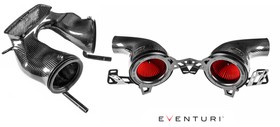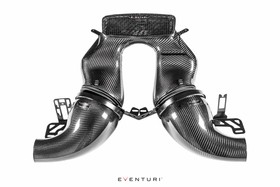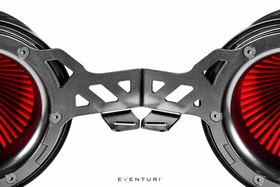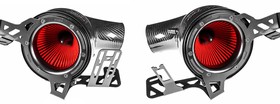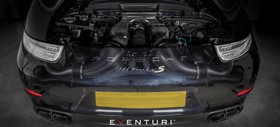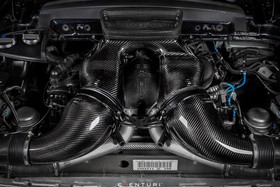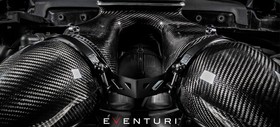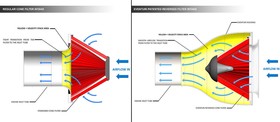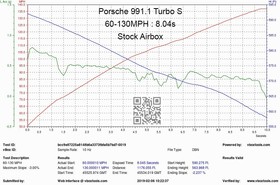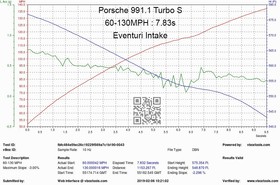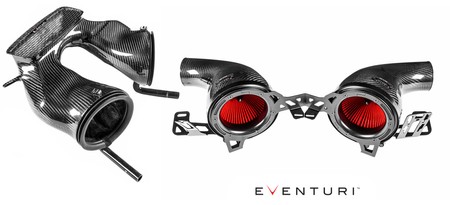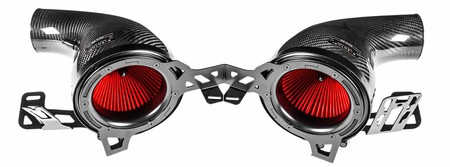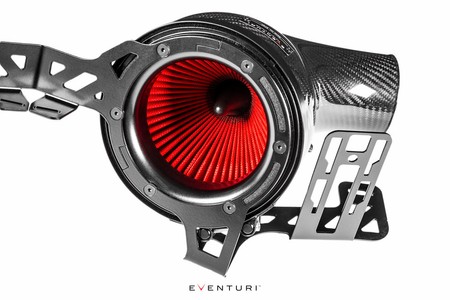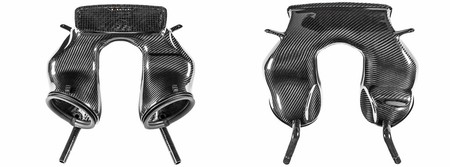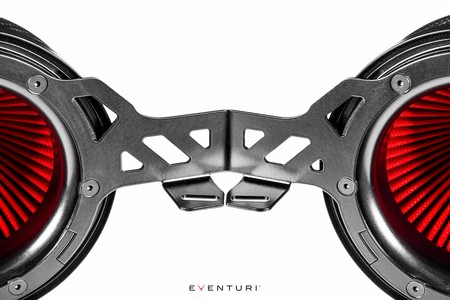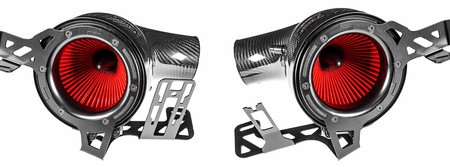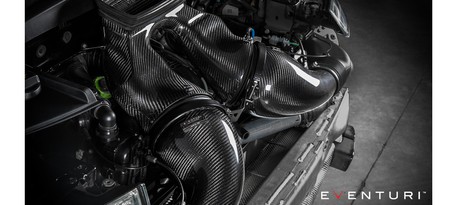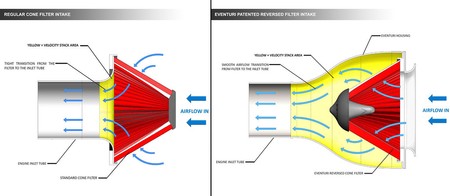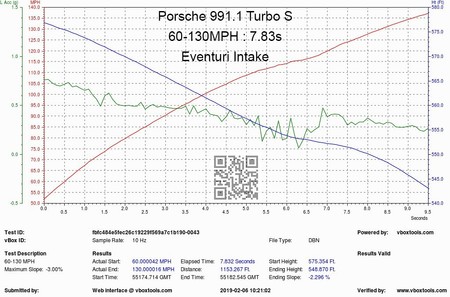Intake system Porsche 991 Turbo Black Carbon Eventuri
Questions before you buy?
Get in touch with us — our specialists will guide you and help you choose the right part. We respond quickly and run our store with full reliability.
Inlet for Porsche 991 Turbo
Acceleration time: 60-130 mph reduced by 0.2 seconds
Fits: Porsche 991.1 991.2 Turbo, Turbo S
The Eventuri 991 Turbo inlet system has been developed based on extensive real-world testing with the aim of allowing the turbochargers to operate more efficiently. By replacing the single factory airbox with individual patented Venturi filter housings, the turbochargers can spin up and generate flow with less resistance. As a result, the cycles of the wastegate are reduced, leading to achieving maximum turbocharger pressure at lower RPMs, thereby increasing efficiency. Two individual filters provide greater filtration surface compared to a single factory flat filter. Additionally, to keep inlet temperatures low, the Venturi housings are sealed against the air channel, which draws ambient air from the same location as the factory system. Because the engine bay of the 911 Turbo is densely packed, high inlet temperatures can only be avoided by ensuring a fully sealed inlet system. Combining a smooth airflow path to each turbocharger with low inlet temperatures results in higher performance and better throttle response compared to the factory airbox.
Eventuri Difference
The Eventuri 911 Turbo system utilizes our patented carbon fiber housings with our Gen 2 filters, providing an aerodynamically efficient airflow path from the filter to the turbocharger. This is not another cone filter with a heat shield, but a unique design that induces the Venturi effect and maintains laminar flow conditions to reduce turbocharger resistance. You can read more about the housing design and its operation HERE.
Performance Testing
The inlet system was tested on the road using a Vbox unit to record acceleration from 60 to 130 mph. Tests were conducted on the same stretch of road - again on the same day to minimize variables. The results show that by simply adding the inlet - on factory software, acceleration times from 60 to 130 mph were reduced by 0.2 seconds, which represents a significant improvement at these speeds.
Summary of acceleration results:
60-130 mph with factory inlet = 8.04 seconds 60-130 mph with Eventuri inlet = 7.83 seconds
The gains come from a combination of several reasons:
-
Individual Venturi housings separate the airflow path for each turbocharger, allowing them to work more efficiently.
-
Venturi housings provide a smooth transition from the filter to the inlet pipes, maintaining laminar airflow.
-
Inlet air temperatures are kept to a minimum by ensuring a sealed system to prevent hot air from the engine bay being ingested.


Eventuri Porsche 911 Turbo Kit

The Eventuri Porsche 991 Turbo inlet system consists of several components designed to meet a specific purpose and made from the highest quality materials.
Each inlet system consists of:
- 2 x Carbon fiber Venturi housings with integrated tubes
- 2 x Unique Gen 2 high-flow filters
- 2 x Aluminum housings
- Carbon fiber inlet pipe
- Laser-cut stainless steel mounting components
Cone Filter Housings

The filter housings consist of our unique Gen 2 filters, aluminum housings, carbon fiber capsules, and integrated tubes. Carbon fiber capsules surround the inverted filters and smoothly shape the airflow down to the factory turbocharger inlet pipes. By separating the inlet path and using a separate filter for each turbocharger, the inlet enables more efficient turbocharger operation. It is significant that the Venturi housings naturally expand in a smooth curve from the filter opening to the factory turbocharger inlet pipes. This ensures that airflow remains as smooth as possible throughout the system. Smooth airflow results in less resistance and allows turbochargers to reach maximum pressure earlier in the RPM range. This also means that throttle response is noticeably more decisive.
Patented Technology
Our patented filter housings have a smooth reduction in cross-sectional area around the filters and taper down into the tubes. This geometry induces the Venturi effect, where airflow accelerates while still maintaining laminar conditions. This can be likened to a large velocity cone - below is a diagram comparing our patented design to a standard inlet system. Our unique filters assist airflow through the housings and provide even velocity profiles as airflow exits the housings.

Air Inlet Pipe

The inlet pipe seals against the bottom of the trunk lid using a factory rubber grommet, then descends down to seal against the filter housings. Made entirely from pre-preg carbon fiber, the inlet pipe ensures that the inlet draws only ambient air and not heated air from the engine bay. Again, to maximize flow efficiency, the transition from circular openings to the filter housings to a single point is as smooth as possible. The air inlet features 2 drainage tubes that direct water away from the filters. The tubes are designed so that the inlets will draw a minimal amount of air from inside the engine bay due to greater flow resistance in the tubes compared to the opening at the top of the inlet pipe. The complex geometry of the inlet pipe was necessary to bypass various components in the 991 Turbo engine bay.

Mounting Bracket

The brackets are laser-cut from stainless steel and powder-coated. We have made every effort to ensure precise fitment of the inlets by utilizing factory airbox mounting locations. The brackets not only stabilize the inlets to the frame but also allow for the mounting of engine components as per the factory airbox. To save weight, each bracket has intentionally cut shapes that remove material while still leaving the structure rigid.

The entire system combines to provide a noticeable and significant improvement in performance compared to the standard airbox.

Type of warranty: manufacturer's warranty.
Warranty period: 24 months.
The manufacturer's warranty means that in the event of a defect or malfunction, the product will be repaired or replaced by an authorized service center. In most cases, proof of purchase (receipt or invoice) is required.
To submit a warranty claim, please contact our store via the warranty claim form. The product must be sent back to us at your own expense. If the claim is approved, we will refund the shipping costs upon presentation of proof of payment.
If you have any questions regarding the warranty conditions or the status of your claim, please contact our customer service department.


